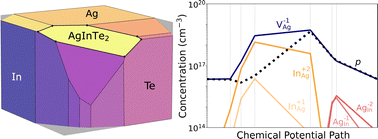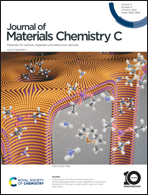Designing for dopability in semiconducting AgInTe2†
Abstract
Ternary chalcogenide semiconductors (e.g., CuInTe2, AgInTe2, AgGaTe2, and Hg2GeTe4) have significant potential for excellent thermoelectric performance if appropriately doped. However, the efficacy of extrinsic dopants in these materials varies widely based on their native defect chemistry. Here, we investigate via first principles calculations and experimental transport measurements how native defect populations in AgInTe2 can be synthetically controlled. First principles calculations predict that acceptor VAg1− vacancies and donor InAg2+ antisite defects are the dominant native defects in AgInTe2. Depending on calculated synthesis conditions, the ratio of these two defect concentrations is predicted to vary by approximately ten orders of magnitude. Experimental transport measurements are correlated with synthetic stoichiometry to assess the predictions of dominant defects and carriers from computation. These results are experimentally tested using two model extrinsic dopants, Zn and Ge. Transport properties of doped samples are considered in regimes where native defects either permit p- or n-type dopability. Beyond impacting the dopability, the native defect concentrations (VAg in particular) correlate with a significant reduction in thermal conductivity (∼0.5 W m−1 K−1). Collectively, these results indicate that degenerate p- and n-type doping of AgInTe2 could be achieved if suitable dopants are identified. In the case of successful n-type doping, we expect the lattice thermal conductivity of such samples to be extremely low.



 Please wait while we load your content...
Please wait while we load your content...